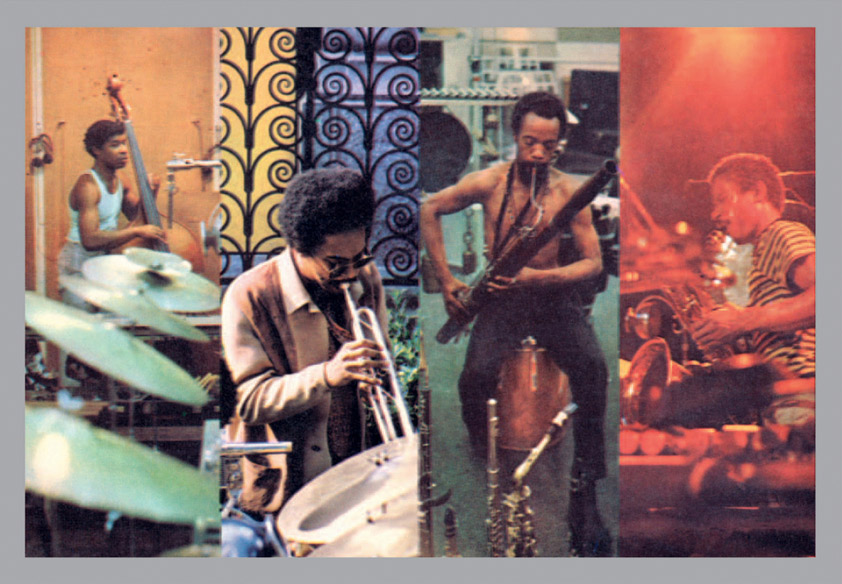RIP Jean Karakos
The incredible life of the Celluloid label boss who brought free jazz, hip-hop, the Lambada and much more to France
On February 24, 1988, the film To the Extreme hit the cinemas in France – an artificially stylized thriller surfing on the ’80s trend of “cops in blue jeans.” The movie was hardly a classic and would have quickly been forgotten if the critics had been less harsh. Journalists were already well acquainted with its director, though. Olivier Lorsac had previously been a much-feared press officer with a bad reputation. Journalists had been privately sharpening their claws, waiting for their moment to strike back.
When he put down his copy of Libération that day, Lorsac knew he would never make another full-length feature. Crucified in its pages, his dreams of motion picture glory were over. He could only think of one solution to this situation: He was ready to blow his brains out. Before putting his plan into practice, he called up an old friend, Jean Karakos, a man with whom he had worked on projects like the legendary Amougie music festival 20 years beforehand. Karakos, head of New York label Celluloid and a man who had also fallen upon hard times, suggested Lorsac join him in Brazil, where he was looking for artists for a new imprint called Breziloïd.
A week later, the two men, pushing 50 and looking for a solution to their woes, ended up in Porto Seguro, in one of the numerous open air dancehalls scattered along the majestic beaches. Before them, couples moved with incredible passion and sensuality. The boys were clad in immaculate white trousers and the girls wore skirts with billowing layers they had changed into for the occasion. The dancers were young and beautiful, moving to the sound of music that combined merengue, salsa and reggae – the Lambada.
Lorsac and Karakos were stunned by the scene and caught a glimpse, between the feverish ballet of bodies, of a business opportunity. They quickly became sure that the Lambada would be their one-way ticket back to relevance. “Celluloid was going to the dogs, I had debts of 1.4 million dollars, and from one day to the next, I ended up on the streets of New York with my wife who wanted to go back to Paris,” Jean Karakos told me recently. “In the middle of all our furniture, right there on the pavement, I said to her: ‘Let’s have a kid.’ She answered: ‘If you want a kid, you’d better get me a hit.’ So, I got her a hit. Then we had a kid!”
I met with Karakos just a few weeks ago and he roared hard with laughter as he told the story. On January 22nd, 2017, the 76 year old entrepreneur passed away.
I had no choice: I leapt in the water without knowing how to swim.
The exploits of Jean Georgakarakos began in the Morbihan region of Brittany, in 1940. His Greek parents had settled there five years beforehand, escaping poverty in their homeland. His father was a bootmaker in Paris; his mother a housewife who took care of his three brothers and sisters as well as four adopted nephews and nieces. He was orphaned at seven.
Raised by a grandmother who didn’t speak a word of French, Karakos would translate for her when they went to the stock exchange on Fridays to sell off the gold coins his father had hidden behind a religious icon. By the age of 16, the school where he punched those who called him a “dirty Greek” was but a distant memory – he was the one who had to keep the family afloat, so he found a job running errands. “I had no choice: I leapt in the water without knowing how to swim,” he adds, without regret.
Rock & roll had just taken France by storm and Karakos instantly fell in love with Elvis and Little Richard. He got behind the mic, and along with his brother took to the stages of any Parisian brasserie willing to put them on under the name Dimi Karas et Jean Rakos, though generally they were applauded with rotten tomatoes rather than accolades. He couldn’t sing to save his life, so he headed backstage.
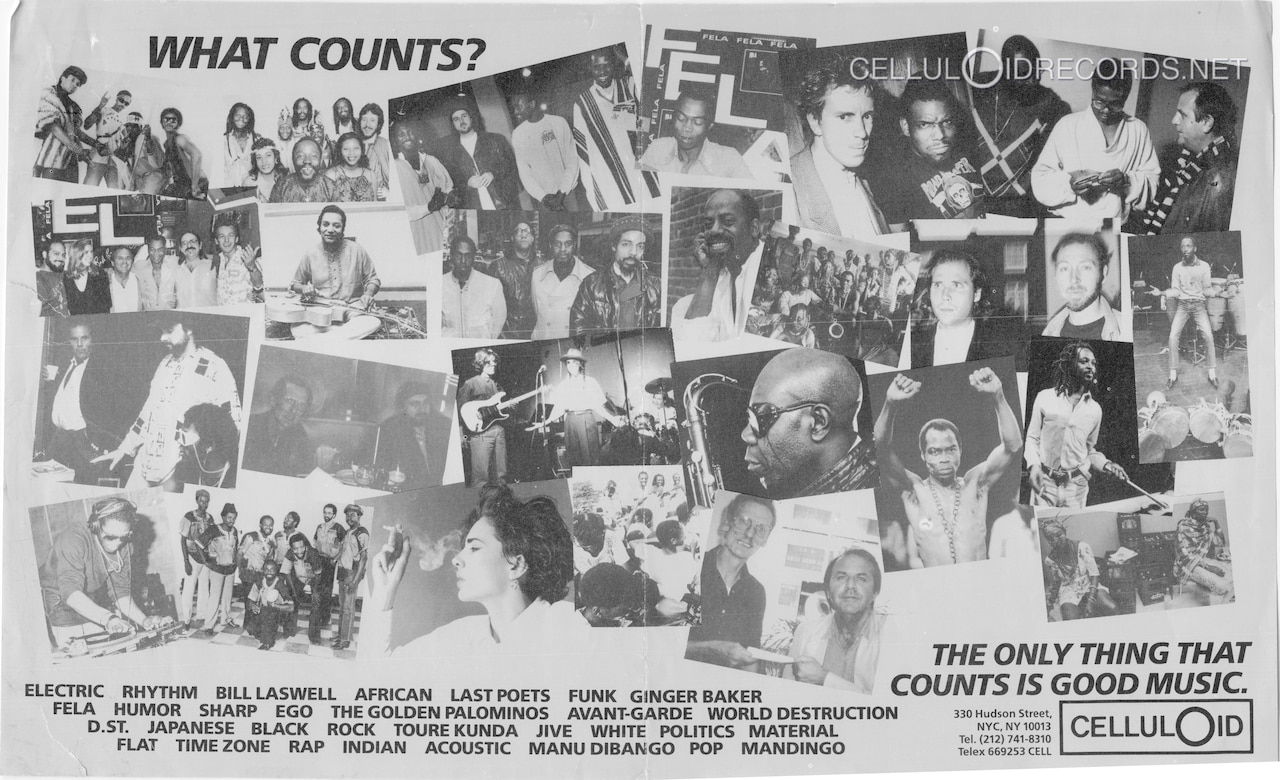
At 20, he launched his first label, Star Success, with money he had saved selling door-to-door life insurance – as charming as he was astute, Karakos made an excellent salesman. With no previous experience in music, he produced a Cuban orchestra and brought out his first record, La Patchanga – a South American music and dance style which was the forerunner of what he would go on to accomplish with the Lambada. “I’d take the metro every morning with the records in my rucksack and I’d go round all the record shops to try and place them. As I was canny, I’d go home with empty bags.” His success wasn’t ignored. Major labels soon came out with similar offerings like “La Patchanga” by Dario Moreno, and Karakos was forced to give up in the face of such heavyweights.
Looking for other music opportunities, Karakos purchased whole containers of mono records from the United States for next to nothing just as the craze for stereo swept the land. It allowed him to get back up on his feet, launching a chain of shops selling “quality [records] at discount prices” in French university towns like Grenoble, Aix, Montpellier and Lyon.
My political contribution [in 1968] was to provide the music and the sound of the revolution which was free jazz.
This was 1968 and a wind of change was blowing across France – students were mounting barricades, paving stones were flying and riot police were charging. Surrounded by insurrectional youth, Karakos left his wife, sold his stores and moved to Paris. Along with Fernand Boruso and Jean Luc Young, he founded a new label, BYG, with the intention of devoting himself to production. “I sympathized with ultra-left ideas, but never wanted to be part of a group, especially not a political one,” he admits. “Meetings to establish the agenda for the next meeting, that wasn’t my thing. My political contribution was to provide the music and the sound of the revolution which was free jazz.”
Partnering with Actuel – a publication dedicated to avant-garde jazz – BYG launched the BYG Actuel series. It brought together the big names of free jazz that sought refuge in Europe after being blacklisted in the United States due to their political activities. “All the musicians I was interested in were to land in the Bourget airport after the Pan African festival in Algiers where they had played before the Black Panthers who were in hiding there,” Karakos remembered. “I’d sent photographer Jacques Bisceglia there and he was in charge of bringing them back. When they arrived, there were two limousines to bring Archie Shepp, Don Cherry and the whole gang to the George V hotel, where I’d booked rooms at unbeatable prices. During a whiskey-fuelled night, I persuaded them to sign an agreement with me. I shared offices with Saravah and had their studio all to myself for two months, a time during which the lion’s share of the 59 titles in the BYG Actuel catalogue were recorded.”
Though BYG became a beacon of free jazz (Sunny Ray, Arthur Jones, Burton Greene and the Art Ensemble of Chicago were also part of their roster), the label also attracted the freaks who loitered in the surrounding streets such as Alan Jack Civilisation, Ame Son and François Wertheimer, as well as others who came from the other side of the globe.
Daevid Allen sat opposite me... And without saying a thing, we began to giggle gently before howling like hyenas for a full ten minutes.
This is how, one day in 1969, journalist Patrice Blanc-Francard turned up with an Australian musician who had just been refused entry into the UK. (Drug possession.) He was supposed to meet up with the members of Soft Machine. “Daevid Allen sat opposite me with his really wacky dress sense,” recalled Karakos. “And without saying a thing, we began to giggle gently before howling like hyenas for a full ten minutes, after which he got up and said to Blanc-Francard: ‘I’m gonna walk with this man.’”
The band Gong was born, and the group released their first two albums on BYG, Magick Brother and Camembert Électrique. Recorded in the Château d’Herouville, they opened France up to the new horizons pioneered by the Canterbury school (Soft Machine, Caravan, Camel and so on), musicians who mixed Dadaist collage as well as pop and jazz-tinged psychedelia with the prog rock prophecies of King Crimson. This style, like free jazz, tore up the rulebook and rewrote the basics under the aegis of improvisation, deconstruction and hard drugs.

The same year he met Allen, Karakos decided to organize a festival under the Actuel banner. For the first time in Europe, he brought together the heroes of free jazz (Art Ensemble of Chicago, Archie Shepp, Don Cherry, Alan Silva, Sunny Murray, etc.), the rock avant-garde (Pink Floyd, Ten Years After, Caravan, Yes, Gong, Soft Machine, Captain Beefheart and so on) as well as contemporary music ensembles (Musica Electronica Viva, G.E.R.M., Acting Trio and more) and French groups playing under the influence (such as Triangle, ZOO and Martin Circus).
All of this was to be presented by Frank Zappa, a genuine prophet of the underground for long-haired disciples in sheepskin jackets. Karakos got turned down by numerous venues in France – les Halles, le Pavillon Baltard and le parc de Saint Cloud were all considered – so the festival eventually took place in Amougies, Belgium. Over the course of five electrifying days almost 80,000 people turned up (50,000 were expected), bringing together as many bourgeois kids trying to walk on the wild side as acid-soaked hippies. Most of the latter gate-crashed the festivities, though, and the artistic and media success was an unmitigated financial disaster, leaving Karakos deep in debt.
Around this time, Karakos met Jean-François Bizot, the son of rich industrialists from Lyon who was then a journalist for l’Express. Bizot shouldered part of the debt in exchange for 50% of Karakos’s shares in Actuel, a publication that he had turned into the agent provocateur of French counterculture. Emboldened, Karakos organized another festival with Biot the following year. “François Wertheimer was in charge of the decoration. He had turned all the pine trees into Christmas trees and built this enormous phallus, three metres high, which emitted these cows that inflated as they went off into the air; that set the scene.”
Again, what Karakos gained in artistic capital was lost in financial terms. After a single, crazed day, he pulled the plug on the event after more than 25,000 revellers arrived without a ticket (and no intention of buying one). Joan Baez played, but acts that had been booked – Pink Floyd, Eric Clapton and Archie Shepp among them – never made it to the stage.
With his head under water, swimming in debt, Jean Karakos nonetheless soldiered on with BYG, producing, amongst others, L’Incendie by Areski-Brigitte Fontaine, as well as a 45 by Vangelis under the name Alpha Beta. However, BYG was forced to file for bankruptcy in 1975. Karakos managed to survive by buying up overstock of Saturday Night Fever and Grease in Germany, and reselling it in Holland.
By speculating on currency exchange rates, he made a profit and founded a company called Tapioca to place records at slashed prices in supermarkets. This scheme allowed him to produce an album by Gong, and another by Magma, as well as the debut single, recorded live, by a young group which was immediately snapped up by a major label – Téléphone. (By the end of the decade, they were arguably the biggest band in France.)
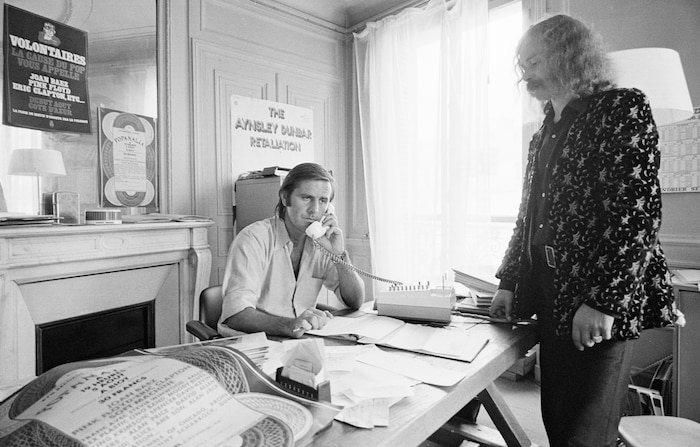
It was the late ’70s and, by this point, the hippies of yesteryear were now piercing their cheeks with safety pins and cutting their hair with garden shears: “Musical waves always follow a wave of societal energy and this was something I felt very strongly at the time,” remembered Karakos. “Bizot then said to me: ‘Karakos, you’re an asshole, you need someone to keep tabs on your shit.’ That’s how he hooked me up with Gilbert Castro... and we launched Celluloid.”
The imprint would eventually become one of the most celebrated independent imprints of the era. But its start was an inauspicious one, “importing records from London where reggae and punk were all the rage.” Though he licensed as many records by U-Roy and Dillinger as by Cabaret Voltaire and Throbbing Gristle, Karakos quickly fell in with a local new wave scene set in motion by the punk explosion. “I used to hang out a lot at the Bains Douches at the time, and that’s where I met Jacno, who usually dropped in for breakfast there towards 11 PM and washed it down with shots of vodka. We quickly became friends. His previous group, the Stinky Toys, had disintegrated in mid-air, so we decided to release his first single, Rectangle, which became an enormous hit and ended up selling 200,000 copies. This is when major labels started getting worried.”
The majors were unhappy with Celluloid because the label kept getting their hands on “jeunes gens mödernes,” like Suicide Romeo, Modern Guy, Nini Raviolette, Marie Et Les Garçons and Mathématiques Modernes. They also released Toure Kounda’s debut album, whose sales of 150,000 copies anticipated the future success of world music. Now at the head of an eclectic, “trendy” and fiercely indie label, Karakos could have become the new tycoon of the French music business. Yet he was already dreaming of the other side of the Atlantic.
The previous year in New York, he had met Bill Laswell in the house of his friend, Giorgio Gomelsky (a legend of Swinging London who managed the Stones as well as Gong, Magma and Can). “He was perched on this ladder, stripping off wallpaper to earn his keep,” says Karakos. “We spent the night talking about music. In the morning, he told me: ‘Us independent musicians, we really need a guy like you to fuck with the program here.’ Back in Paris, I had made my mind up, but my partners at Celluloid – Bizot and Castro – prevented me from leaving before I had come up with a string of hits. So, I showed them ‘OK Fred’ by Errol Dunkley, ‘Jukebox Babe’ by Alan Vega and ‘Tainted Love’ by Soft Cell, and then I left.”
In New York, Jean Karakos went back to square one, going door to door, persuading record shops to stock the Celluloid releases he kept in his hotel room: “Castro would send them to me by boat, and the building almost collapsed. When the owner opened my door, he really lost it – the room was stacked with records, right up to the ceiling,” he laughed. The Kraftwerkian dandyism of Jacno and Mathématiques Modernes found its place easily among the shards of New York no wave annihilating musical genres at the time – jagged guitars and busted synths corrupted in the Manhattan skyline with the jerky beats of an epileptic encephalogram.
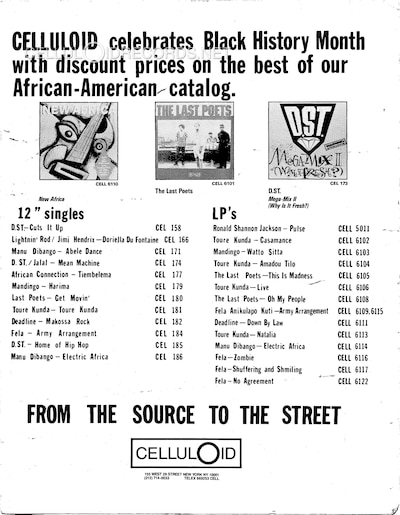
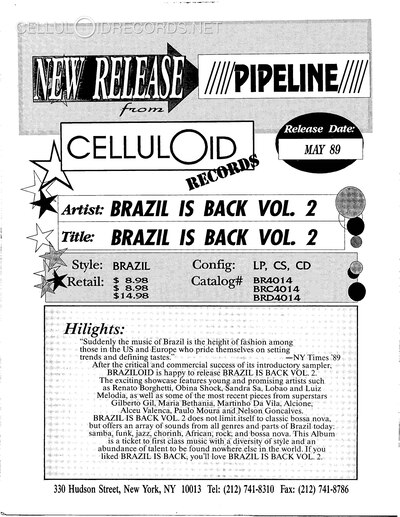
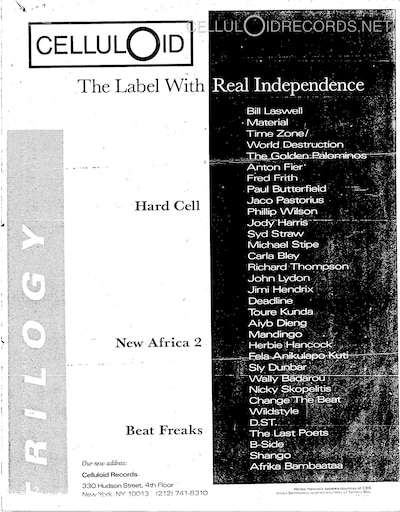
Karakos also renewed his relationship with Bill Laswell, who was then at the forefront of the collision between jazz, funk, dub and world music with his new project, Material. Their first albums were released on Celluloid (and incidentally revealed Whitney Houston to the world on an unlikely cover of Soft Machine!). The project quickly established Laswell as one of the great producers of the ’80s.
Bernard Zekri, a friend from Paris who had moved to New York, changed Karakos’ life though, introducing him to an important emerging scene: “All the American girls were crazy about Bernard, who was the epitome of French chic. He was terminally broke, but could get into any nightclub he wanted. We had this deal where I would pay the rent of his flat on St Marks Place and he would seek out talent for Celluloid. That’s how he introduced me to Grand Mixer D.St., Futura 2000, Afrika Bambaataa and all that gang who were inventing hip-hop at the time. The Bronx was in complete turmoil and they had decided to find a way out of there through music. Dance, graffiti and rap, that was their rock & roll – it was a complete flash of lightning.”
Five 12-inch records produced by Laswell and designed by Futura 2000 were the result, and these releases launched hip-hop in France. Summoned back to his home by Bizot, Castro and Henri de Bodinat (co-editor of the magazine Actuel at the time), “the message was simply ‘No more fooling around, come back to Paris!’ So I answered: ‘Fuck off,’ and left them the shares I had in Celluloid Paris to go back to New York, where we cut ‘Rock It!’”
Initially skeptical of hip-hop, Bill Laswell, who was to produce Future Shock for Herbie Hancock, let himself be carried along by Karakos’s enthusiasm: “He really got the point of using a scratch as if it were a rhythmical instrument, and that’s how Grand Mixer D.St. ended up on ‘Rock It!’ Throughout his life, Hancock had conducted musical experiments, especially with the Head Hunters album, but very few of these had worked out. For him, hip-hop was an energy and a brand-new world. It pulled jazz upwards and allowed Hancock to reach thousands of new listeners.”
The groundbreaking record was still somehow not enough to rescue the finances of Karakos, though. His work in promoting world music via production work for Toure Kunda and Manu Dibango, as well as releasing records by Kassav, Fela Kuti and Youssou N’Door, wasn’t enough to pull him out of debt. Karakos was forced to sell Celluloid US to the mafia in 1989, for the token cost of a dollar. In exchange, his debts were erased.
And so Karakos went to Brazil, where he went out dancing with failed film director Olivier Lorsac. “The Lambada was a regional and grassroots phenomenon which had been completely ignored by the majors,” explained Karakos. “So I bought all the catalogues available in Brazil. Thousands of tracks, and among them was ‘Chorando Se Foi,’ that we discovered on a cassette Lorsac had tracked down on a market.” To interpret what was to become an international hit, he returned to France and formed the band Kaoma with Toure Kunda’s musicians who had just been fired, along with Brazilian songstress Loalwa Braz, who was doing odd jobs in Paris. “My plan was to form the first international world music band, with excellent live musicians.” But for this plan to work out as expected, Karakos had to sign a pact with forces larger than himself: TF1 (a French TV channel), Sony and Orangina. “As soon as I decided to enter the system, I had to accept the process,” he admitted.
On June 21st, 1989, “The Lambada” was played seven times on TF1 during a special event organized on the champ de Mars in Paris for France’s Music Festival. The next day, the single was released: “The 7,000 records we initially placed were all sold in a day, 25,000 were shifted on the second day, and so on.” With its diabolical video on heavy rotation, with its two kids (Chico and Roberta) falling in love surrounded by dancers in thongs shaking Orangina bottles, “La Lambada” became the song of the summer in France and was automatically catapulted to an international level by Sony, which was headed by Henri De Bodinat at the time.
With over five million singles sold worldwide, the song attracted immediate attention: “As soon as it was released, a mate in publishing warned us that he had already seen ten guys claiming to have composed the track.” In a panic, Lorsac registered the track with the French copyright authorities under a pseudonym (Chico de Oliveira) as he waited to locate the author and composer. “We really wanted to control the publishing and not end up with a version sung by [local entertainers like] Carlos. But when Lorsac said that to me after the fact, I said ‘Well, that’s stupid, that’ll bring us trouble.’”
The scandal broke in Le Monde in late August, and Karakos was cast in the unfortunate role of a con artist exploiting third world musicians and using the promotion of world music as his cover: “I was even accused of being a colonialist,” he chuckled. EMI then counter-attacked by claiming that the Gonzalo brothers and Ulises Hermosa from Bolivian group Los Kjarkas were the authors and composers of “Chorando Se Foi.” Karakos and Lorsac abandoned 60% of their rights in order to avoid a lengthy trial involving the major label and finally make the most of the colossal income generated by “La Lambada.”
When I asked him how much money the track made, Karakos simply answered “Cash…,” with a cheeky grin. It also gave him a reputation as a rip-off merchant. To this, Karakos claimed that the whole thing “was a rumor started by the majors, as I had been pissing in their pool all my life. I respect individuals, but the way they treat music and musicians, their modus operandi based on short-term returns, that has no relation to what an artist is.”
At an age when most boomers make the most of their ample pensions and spend their holidays in the sun, Karakos was going full speed ahead last month. He was still launching labels (including Distance, devoted to techno) and releasing records. His next release was due to be a tribute to the legends of Congolese rumba – his way of going back to the roots of the music he has always loved. Before leaving, I asked him if he had any regrets. Jean Karakos scratched his head and rummaged through his memories before coming up with an answer. “Public Enemy, I turned them down. Flavor Flav would come to our Celluloid offices every day in New York to play me his tracks. He was doing my head in, so I said no. That was my first true fuck up.”
On January 22, 2017, Jean Karakos left us to embark on his final journey. All our thoughts are with his nearest and dearest. This interview was conducted on December 13th, 2016.
Header image © Jean-Claude Deutsch

